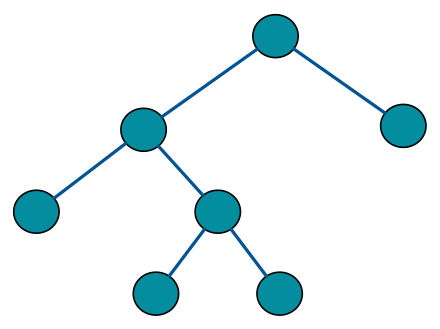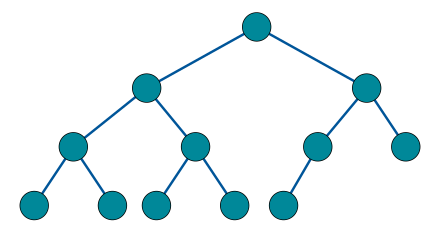定义
二叉树(Binary Tree)是一种数据结构,它的每个父节点(parent)至多有两个子节点(children),分别被称为左孩子(the left child)和右孩子(the right child).

如上图所示, 该二叉树的大小(size)为9且高度(height)为3,根结点(root)的值为2. 另外,这是一棵不平衡(unbalanced)且未排序(unsorted)的二叉树。
特殊二叉树
- 完美二叉树(perfect binary tree)
二叉树属性
- 在任意二叉树中,度数为2节点的个数等于叶子节点的个数减1
节点的度数等于其子节点的个数。因此,在二叉树中,节点的度数只可能为0,1和2。
当只有1个节点时,度为0。接着,每多出1个节点,同时会派生出1度。派生出的度和派生出的节点数一定相等。即:
节点总数 = 总度数 + 1
假设在一棵二叉树中,度数为2的节点数为X2,度数为1的节点数为X1,度数为0的节点数为X0。结合上式:
X2 + X1 + X0 = 2X2 + X1 + 1,推出 X2 = X0 - 1
因此,度数为2的节点个数等于叶节点数减1
- 满二叉树定理:非空满二叉树的叶节点数等于其分支节点数加1
证明同上。在满二叉树中,度数为1的节点数为0。
当仅有根节点时:二叉树有2个空子树,1个节点,结论成立。
接着,空子树和节点等量增长,结论成立。
- 满二叉树最少有2h+1个节点,最多有2^(h+1)-1个节点 (仅有根节点的二叉树的高度为0)
- 在完美二叉树中,假设叶子结点的个数为l,高度为h,则l=2^h,总结点个数n=2^(h+1)-1
二叉树算法
二叉树的结点
1
2
3
4
5
6
7
| template <class elemType>
struct binaryTreeNode
{
elemType info;
binaryTreeNode<elemType> *left;
binaryTreeNode<elemType> *right;
};
|
二叉树的高度
1
2
3
4
5
6
7
8
| template <class elemType>
int height(binaryTreeNode<elemType> *btn)
{
if (btn == NULL)
return 0;
else
return 1 + max(height(btn->left), height(btn->right));
}
|
二叉树的复制
1
2
3
4
5
6
7
8
9
10
11
12
13
14
| template <class elemType>
void copyTree(binaryTreeNode<elemType>* &copiedTreeRoot,
binaryTreeNode<elemType>* otherTreeRoot)
{
if (otherTreeRoot == NULL) {
copiedTreeRoot = NULL;
}
else {
copiedTreeRoot = new binaryTreeNode<elemType>;
copiedTreeRoot->info = otherTreeRoot->info;
copyTree(copiedTreeRoot->left, otherTreeRoot->left);
copyTree(copiedTreeRoot->right, otherTreeRoot->right);
}
}
|
二叉树的遍历 (traverse)
- 前序遍历:根->左->右
- 中序遍历:左->根->右
- 后序遍历:左->右->根
递归遍历
1
2
3
4
5
6
7
8
9
10
11
12
13
14
15
16
17
18
19
20
21
22
23
24
25
26
27
28
29
|
template <class elemType>
void preorder(binaryTreeNode<elemType> *btn)
{
if (btn == NULL) return;
cout << btn->info << " ";
preorder(btn->left);
preorder(btn->right);
}
template <class elemType>
void inorder(binaryTreeNode<elemType> *btn)
{
if (btn == NULL) return;
inorder(btn->left);
cout << btn->info << " ";
inorder(btn->right);
}
template <class elemType>
void postorder(binaryTreeNode<elemType> *btn)
{
if (btn == NULL) return;
postorder(btn->left);
postorder(btn->right);
cout << btn->info << " ";
}
|
迭代遍历
需要额外的一个栈stack结构来辅助实现
1
2
3
4
5
6
7
8
9
10
11
12
13
14
15
16
17
18
19
20
21
22
23
24
25
26
27
28
29
30
31
32
33
34
35
36
37
38
39
40
41
42
43
44
45
46
47
48
49
50
51
52
53
54
55
56
57
58
59
60
61
62
63
64
65
66
67
68
69
70
71
72
73
74
75
|
template <class elemType>
void preorderIteration(binaryTreeNode<elemType> *root)
{
stack<binaryTreeNode<elemType>*> st;
if(root)
st.push(root);
while(!st.empty()){
binaryTreeNode<elemType> *cur = st.top();
st.pop();
cout << cur->info << " ";
if(cur->right)
st.push(cur->right);
if(cur->left)
st.push(cur->left);
}
}
template <class elemType>
void inorderIteration(binaryTreeNode<elemType> *root)
{
stack<binaryTreeNode<elemType>*> st;
binaryTreeNode<elemType> *cur = root;
while(cur || !st.empty()){
if(cur){
st.push(cur);
cur = cur->left;
}
else{
cur = st.top();
st.pop();
cout << cur->info << " ";
cur = cur->right;
}
}
}
template <class elemType>
void postorderIteration(binaryTreeNode<elemType> *root)
{
stack<binaryTreeNode<elemType>*> st;
binaryTreeNode<elemType> *pre;
if(root)
st.push(root);
while(!st.empty()){
binaryTreeNode<elemType> *cur = st.top();
if((!cur->left && !cur->right) || (pre && (cur->left == pre || cur->right == pre))){
st.pop();
cout << cur->info << " ";
pre = cur;
}
else{
if(cur->right)
st.push(cur->right);
if(cur->left)
st.push(cur->left);
}
}
}
|
层次遍历 (Breadth-First Search)
需要额外的一个队列queue结构来辅助实现。
大致思想为:队列初始化时只有根节点,每个节点出队列时,将它子节点加入队列。
1
2
3
4
5
6
7
8
9
10
11
12
13
14
15
16
17
18
19
| template <class elemType>
void BFS(binaryTreeNode<elemType>* btn) {
if(btn == nullptr)
return;
queue<binaryTreeNode<elemType> *> que;
que.push(btn);
while(!que.empty()){
binaryTreeNode<elemType> *q = que.front();
cout << q->info << " ";
que.pop();
if(q->left != nullptr)
que.push(q->left);
if(q->right != nullptr)
que.push(q->right);
}
}
|
二叉树的算法思路:仅考虑当前结点的任务,将其余部分交给递归或迭代框架。其算法框架大致为:
1
2
3
4
5
6
7
8
9
| template <class elemType>
void BTFramework(binaryTreeNode<elemType>* btn, int target) {
if (btn->val == target)
DoSometing;
if (btn->left != nullptr)
BTFramework(btn->left, target);
if (btn->right != nullptr)
BTFramework(btn->right, target);
}
|
这个以后再细说。。。
代码下载地址:https://xiaoli777.github.io/codes/BinaryTree.cpp


